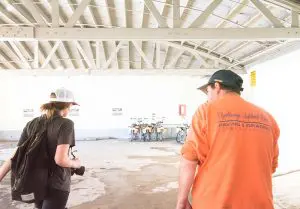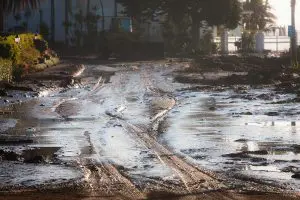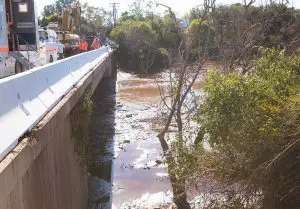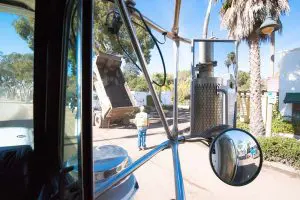
The Montecito Mudslides | A Local Marketing Perspective
 Our team just returned from Montecito, California in the middle of Santa Barbara County’s aftermath of the Montecito mudslides. As locals, and local marketing experts, we know that flooding is unlikely for the small hillside town of Montecito that runs from hill to sea. But the early morning hours of January 10th sent heavy rains and a series of mudslides that plummeted the same hillsides recently burned by the Thomas Fire, which destroyed 1,000 structures and sent residents on evacuations and standbys for weeks as the largest wildfire in state history. And the mudslides took more, piling loss on top of pain and taking at least 20 additional lives and at least 73 more homes. That night, streets became rivers and houses ripped in half while cars tore from garages and trees from their roots.
Our team just returned from Montecito, California in the middle of Santa Barbara County’s aftermath of the Montecito mudslides. As locals, and local marketing experts, we know that flooding is unlikely for the small hillside town of Montecito that runs from hill to sea. But the early morning hours of January 10th sent heavy rains and a series of mudslides that plummeted the same hillsides recently burned by the Thomas Fire, which destroyed 1,000 structures and sent residents on evacuations and standbys for weeks as the largest wildfire in state history. And the mudslides took more, piling loss on top of pain and taking at least 20 additional lives and at least 73 more homes. That night, streets became rivers and houses ripped in half while cars tore from garages and trees from their roots.
Touring the Damage
 As we toured Montecito’s damage along Butterfly beach, we noticed chocolate-colored mud water draining into the ocean below the Biltmore. We spoke to families who had lost homes and were staying in hotels indefinitely; many who were considering moving away given the uncertainty of what the next big storm will bring. The Montecito mudslides only deposited some of the debris basin. The risk for future mudslides to the hillsides scarred from the fire is now only slightly reduced. It’s unknown how the mountains will react during another storm, especially in susceptible areas.
As we toured Montecito’s damage along Butterfly beach, we noticed chocolate-colored mud water draining into the ocean below the Biltmore. We spoke to families who had lost homes and were staying in hotels indefinitely; many who were considering moving away given the uncertainty of what the next big storm will bring. The Montecito mudslides only deposited some of the debris basin. The risk for future mudslides to the hillsides scarred from the fire is now only slightly reduced. It’s unknown how the mountains will react during another storm, especially in susceptible areas.
 The more people we talked with, the more loss we saw. Families separated, homes destroyed, and people in shock. Families allowed to go back to their homes to save their fish. People who, if the 101 hadn’t been there to gulp up the mud and debris would have been gulped up themselves. Or families staying at hotels indefinitely in small rooms without their belongings or clothing, and unsure how long insurance will take to pay the claims, how to file, and if they ever will. People who had just started working at businesses like the San Ysidro Ranch that had all but swept away. Or from our family members who had friends staying at their hotel, the Montecito Inn, when the floods hit and the entire ground floor and lower parking garage filled with mud and debris. Or other family members who’s crews couldn’t work without the ability to move material.
The more people we talked with, the more loss we saw. Families separated, homes destroyed, and people in shock. Families allowed to go back to their homes to save their fish. People who, if the 101 hadn’t been there to gulp up the mud and debris would have been gulped up themselves. Or families staying at hotels indefinitely in small rooms without their belongings or clothing, and unsure how long insurance will take to pay the claims, how to file, and if they ever will. People who had just started working at businesses like the San Ysidro Ranch that had all but swept away. Or from our family members who had friends staying at their hotel, the Montecito Inn, when the floods hit and the entire ground floor and lower parking garage filled with mud and debris. Or other family members who’s crews couldn’t work without the ability to move material.
 Santa Barbara Country
Santa Barbara Country
Montecito’s physical damage will affect its once-pristine streets for months. Currently, Santa Barbara County is moving thousands of tons of mud wherever it can, including along the side of the freeway in Goleta, along Carpinteria’s beaches known as some of the world’s safest, and even on vacant land. Meanwhile, businesses in the hardest-hit Montecito as well as those affected in Carpinteria, Santa Barbara, and Ventura, will face the challenge of rebuilding. While larger businesses may be better equipped to repair from damage, smaller businesses such as those along Coast Village Road and San Ysidro Village may take longer to return to business. To assist, Santa Barbara County will bring merchants in within the next few days to assess damages.
Local Marketing After a Disaster
One might say that even after the devastation in Southern California, the work is far from over. Now the community will have to rebuild. Homes rebuilt, businesses restored, and lives pieced back together. For parts of Southern California, the past couple of months have seen uncertainty, stress, and near-devastation. For those spared some of it, the idea of business-as-usual may seem not only bittersweet but near impossible. But eventually our community will rebuild, and a healthy business community means a healthy local community.
Resuming Local Marketing Following the Recovery
For those businesses ready to get back to business, how do you communicate during times like this? We’ve heard all the questions from local businesses. Is now the time to run ads showing we can help? Is now the time to let our customers know we’re open? And, if so, what’s the best way? Or if a business is closed due to the flooding, how do we communicate with guests and customers when we don’t know when we’ll open again?
Following natural disasters, small businesses need to be strategic with their marketing. If you’re offering to help by way of discounts or other offers, be sure they serve the community before they serve your business. Everything should first ensure basic needs are being met. If they’re not, consider having your business help donate to those in need, or donate back to those affected in every sale you make.
Support Your Customers, and Your Community
Lastly, make sure any messaging you use is in support of your customers and your community. Those affected don’t care about your businesses’ returns during these times; they care about getting back to their normal. If your products or services can help with that, great, but do so mindfully and with care. How you market during and after natural disasters such as wildfires, flooding, and mudslides can either help your business and your customers or not help either. Because, if you’re not helping you won’t win.
One example is the Village Wine and Cheese shop on East Valley Road. The shop has modified its store into a small short order restaurant. Its owners have woken early each day to help feed residents and first responders since the slides. They’ve also organized supplies for the community and coordinated with others such as The Anderson Restaurant and Bakery to help. These businesses are just one shining example of finding ways to give back and keep the doors open at the same time.
From a local marketing perspective, the focus should be on goodwill and helping to restore the community. As a small business, you can keep your doors open while still serving the greater good.
How else do you think local marketing can work during and after natural disasters? Let us know in the comments below. Also, for more small local marketing tips, read our blog.
Stay #santabarbarastrong Santa Barbara County. #805strong
Recent Posts
Custom Website Design and Development vs. Off-the-Shelf: What’s Right for Your Business?
Having a website that represents your brand and serves your business effectively can make or break your success in 2025. This poses the important question: Should you opt for custom […]
Read MoreHow to Rebrand Your Instagram for Better Engagement and Brand Recognition
Your Instagram presence can act as a beacon for brand recognition and customer engagement. It’s about painting a picture so compelling that your audience cannot help but be drawn to […]
Read MoreFrom Clicks to Conversions: The Science of High-Performing Digital Ads
The journey from interest to purchase is often paved with digital advertisements. However, not all digital ads are crafted equally. While some fade into the background, others command attention and […]
Read MoreBrand Consistency Examples That Will Make You Rethink Your Marketing Strategy
A consistent and strategic brand identity across all platforms is not just beneficial; it’s essential. By exploring real-world brand consistency examples, we uncover the immense power of maintaining a coherent […]
Read More3 Ways to Transform Blogs With SEO and Make Google Love Your Content
As marketers and business owners, our goal is to ensure the blogs we publish confidently stride into the spotlight of Google’s top search results. Achieving this requires great content, but […]
Read More



